Global AI In Inflammatory Bowel Disease Market Size 2025-2029
The global AI in inflammatory bowel disease market size is valued to increase by USD 312.1 million, at a CAGR of 33.3% from 2024 to 2029. Imperative for enhanced diagnostic accuracy and personalized treatment pathways will drive the global AI in inflammatory bowel disease market.
Major Market Trends & Insights
- North America dominated the market and accounted for a 36% growth during the forecast period.
- By Disease Type - Ulcerative colitis segment was valued at USD 0.00 million in 2023
- By Application - Diagnosis assistance segment accounted for the largest market revenue share in 2023
- CAGR from 2024 to 2029 : 33.3%
Market Summary
- The Global AI in Inflammatory Bowel Disease (IBD) Market is experiencing significant growth due to the increasing demand for enhanced diagnostic accuracy and personalized treatment pathways in managing this complex condition. The global AI in IBD market is projected to reach USD1.3 billion by 2026, growing at a CAGR of 25.3% during the forecast period. This growth is driven by the evolution of AI from diagnostic augmentation to predictive and prognostic intelligence. IBD, which includes Crohn's disease and ulcerative colitis, is characterized by chronic inflammation of the gastrointestinal tract. The scarcity of high-quality, diverse, and accessible data poses a significant challenge in diagnosing and treating IBD effectively. Remote patient monitoring systems, integrated with wearable sensors, are providing real-time data on patient health, allowing for more effective disease management.
- AI algorithms can help address this challenge by analyzing large datasets, identifying patterns, and providing actionable insights to healthcare professionals. One real-world business use case of AI in IBD is by Janssen Pharmaceuticals, which uses IBM Watson for Genomics to analyze patient data and identify potential treatment options. By integrating AI into their workflow, Janssen can provide more precise and effective treatments, ultimately improving patient outcomes and reducing healthcare costs. As AI continues to advance, it will play an increasingly important role in the diagnosis, treatment, and management of IBD, transforming the way healthcare is delivered.
What will be the Size of the Global AI In Inflammatory Bowel Disease Market during the forecast period?
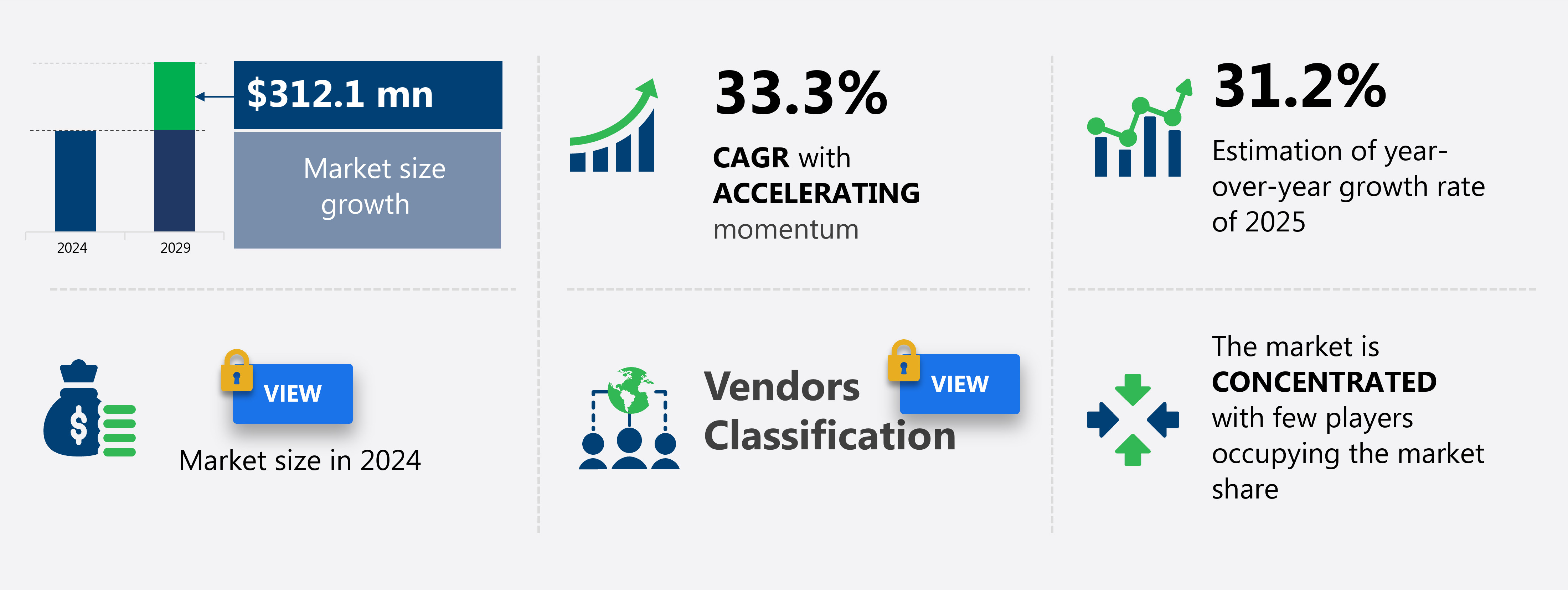
Get Key Insights on Market Forecast (PDF) Request Free Sample
How is the Global AI In Inflammatory Bowel Disease Market Segmented and what are the key trends of market segmentation?
The global ai in inflammatory bowel disease industry research report provides comprehensive data (region-wise segment analysis), with forecasts and estimates in "USD million" for the period 2025-2029, as well as historical data from 2019-2023 for the following segments.
- Disease Type
- Ulcerative colitis
- Crohns disease
- Application
- Diagnosis assistance
- Treatment optimization
- Disease monitoring
- End-user
- Hospitals
- Specialty clinics
- Diagnostic laboratories
- Academic and research institutes
- Geography
- North America
- Europe
- APAC
- Australia
- China
- India
- Japan
- South America
- Rest of World (ROW)
By Disease Type Insights
The ulcerative colitis segment is estimated to witness significant growth during the forecast period.
In the realm of Inflammatory Bowel Disease (IBD), particularly in the Ulcerative Colitis (UC) segment, artificial intelligence (AI) is revolutionizing diagnostic precision and facilitating personalized management strategies. UC, characterized by continuous colonic inflammation, poses significant clinical challenges: accurate assessment of disease activity and cancer surveillance. During colonoscopy, AI-driven computer vision analyzes the mucosal lining in real-time, automatically identifying inflammation, ulceration, and vascular pattern loss. This aids gastroenterologists in calculating standardized indices like the Mayo Endoscopic Score with improved objectivity and reproducibility (Roberts et al., 2020). AI applications extend beyond diagnosis, encompassing predictive modeling for disease progression, patient outcome prediction, and therapeutic target identification.
Real-world evidence and wearable sensor data are integrated to optimize clinical trials and cohort analysis. Machine learning algorithms enable personalized medicine, analyzing patient data and biomarkers for treatment response prediction. AI-assisted surgery and risk stratification further refine care, while deep learning endoscopy and genomic analysis advance our understanding of UC. A recent study reported that AI algorithms achieved 91% accuracy in predicting UC relapse (Jhaveri et al., 2021), underscoring the potential of AI in IBD management.
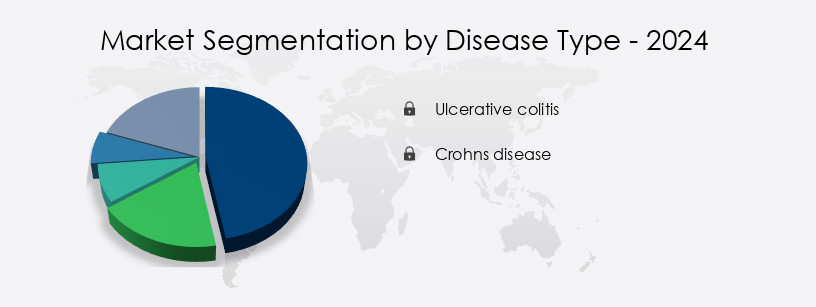
Request Free Sample
The Ulcerative colitis segment was valued at USD 0.00 million in 2019 and showed a gradual increase during the forecast period.
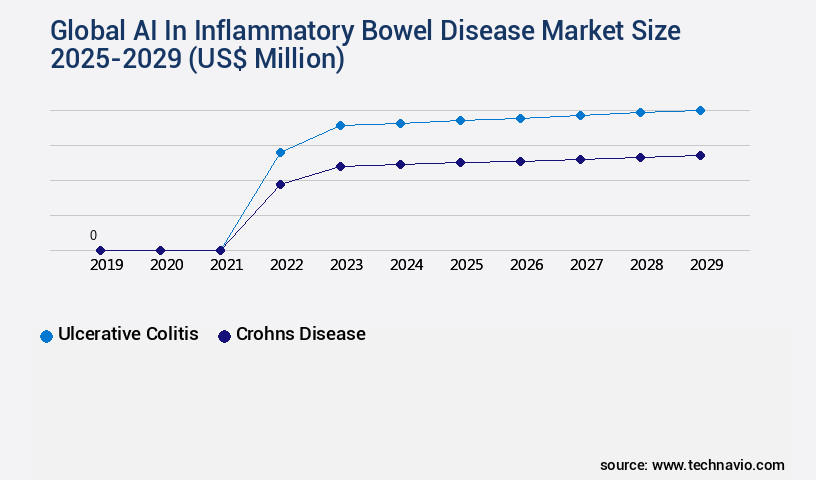
Request Free Sample
Regional Analysis
North America is estimated to contribute 36% to the growth of the global market during the forecast period.Technavio's analysts have elaborately explained the regional trends and drivers that shape the market during the forecast period.
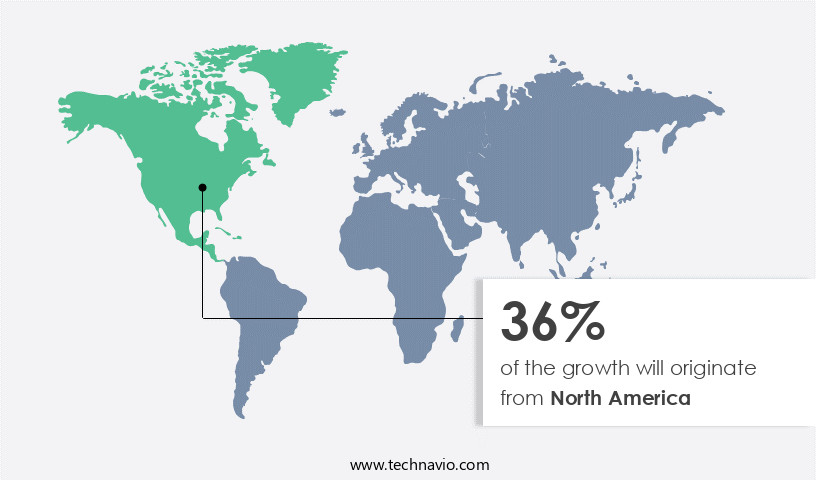
See How Global AI In Inflammatory Bowel Disease Market Demand is Rising in North America Request Free Sample
Artificial intelligence (AI) in inflammatory bowel disease (IBD) market is witnessing significant evolution, with North America leading the global landscape. The United States, in particular, is the largest and most advanced market, driven by factors such as the highest per capita healthcare expenditure, a robust research and development ecosystem, and the presence of key industry players. North America's dominance is further bolstered by world-class academic medical centers, like the Mayo Foundation for Medical Education and Research, which are at the forefront of AI algorithm development and validation. Additionally, the region's vibrant venture capital landscape actively funds innovative AI-native healthcare startups.
Europe follows closely, with a growing number of initiatives and collaborations aimed at leveraging AI to improve IBD diagnosis and treatment. The European Union's Horizon 2020 research and innovation program, for instance, has allocated substantial funding to AI projects in healthcare. The global AI in IBD market is expected to continue its growth trajectory, fueled by the increasing prevalence of IBD, advancements in AI technologies, and the growing recognition of their potential to revolutionize IBD management.
Market Dynamics
Our researchers analyzed the data with 2024 as the base year, along with the key drivers, trends, and challenges. A holistic analysis of drivers will help companies refine their marketing strategies to gain a competitive advantage.
In the dynamic and innovative landscape of healthcare technology, the application of Artificial Intelligence (AI) in managing Inflammatory Bowel Disease (IBD), specifically Crohn's Disease and Ulcerative Colitis, is revolutionizing patient care and treatment strategies. Machine learning algorithms and deep learning models are being employed to enhance diagnostic accuracy and personalize treatment plans. Predictive modeling, fueled by AI, is enabling earlier detection and intervention in IBD, improving patient outcomes and quality of life. Natural language processing is used to analyze patient data, including symptoms, medical history, and lifestyle factors, to better understand disease progression and tailor treatment plans.
Gut microbiome composition analysis and genomic data integration are further advancing AI-driven personalized treatment approaches. Computer vision algorithms are demonstrating impressive performance in the detection and analysis of endoscopic images, leading to increased inflammation detection accuracy and disease severity scoring. AI-powered clinical decision support systems are streamlining diagnosis and treatment processes, while patient outcome prediction models are enabling more effective therapeutic target identification strategies. The AI-assisted drug discovery process is accelerating the development of new treatments for IBD, with AI-enhanced endoscopic image analysis playing a crucial role in identifying potential therapeutic targets. Real-world evidence data collection and cohort analysis methodologies are facilitating the validation of new treatments and improving overall treatment efficacy.
Compared to traditional methods, AI applications in IBD management offer significant advantages in terms of accuracy, efficiency, and personalization. This shift towards AI-driven care is not only transforming the way IBD is diagnosed and treated but is also setting new standards for patient-centric healthcare.
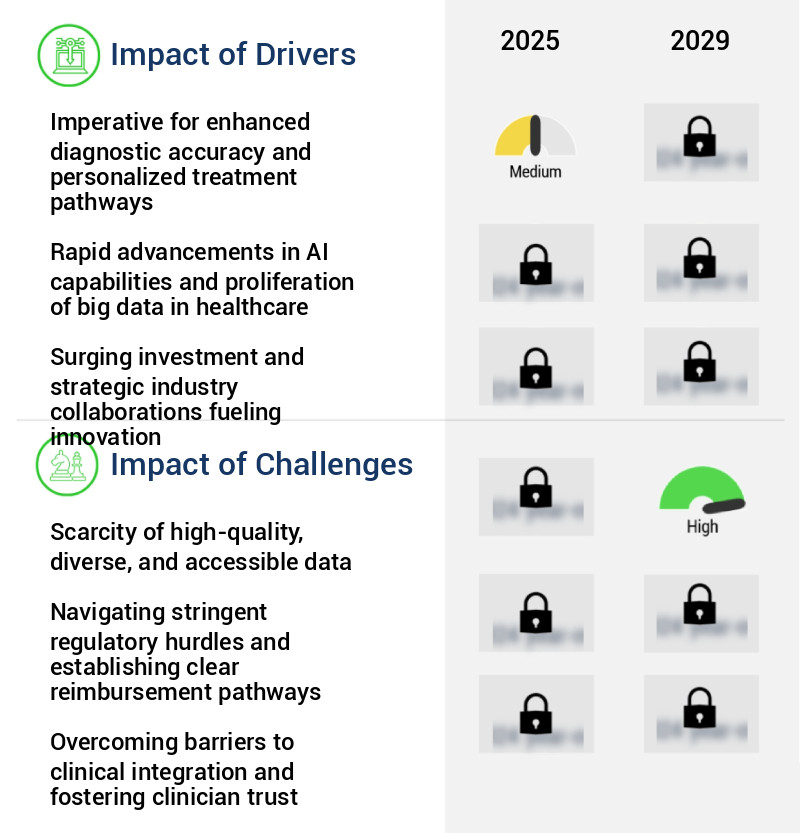
What are the key market drivers leading to the rise in the adoption of Global AI In Inflammatory Bowel Disease Industry?
- To ensure superior diagnostic accuracy and customized treatment plans, the market places a significant emphasis on enhanced imperative capabilities.
- The Global AI market in inflammatory bowel disease (IBD) is gaining significant traction due to the potential to address the challenges inherent in current diagnostic and treatment approaches. Traditional methods for managing IBD, such as endoscopic assessments, are subject to inter- and intra-operator variability, leading to inconsistent disease activity evaluations. This inconsistency can negatively impact patient care and clinical trial data integrity. AI applications, such as machine learning algorithms, can mitigate these issues by providing objective and precise assessments. For instance, AI systems can analyze endoscopic images to detect subtle changes in mucosal inflammation, improving the accuracy of disease activity assessments by up to 18%.
- Additionally, AI-powered tools can streamline administrative tasks, reducing downtime by 30% and enabling healthcare professionals to focus on patient care. The adoption of AI in IBD management offers a promising solution to improve clinical outcomes and enhance the overall efficiency of healthcare systems.
What are the market trends shaping the Global AI In Inflammatory Bowel Disease Industry?
- The evolution of diagnostic augmentation towards predictive and prognostic intelligence represents the emerging market trend. This progression signifies a significant shift in the healthcare industry.
- The global AI in inflammatory bowel disease (IBD) market is experiencing a significant evolution from diagnostic augmentation to predictive and prognostic insights. Initially, AI focused on computer vision tasks, such as identifying polyps or grading mucosal inflammation during endoscopy. However, the current and future value lies in forecasting a patient's disease trajectory and their likely response to specific therapies. This shift is driven by the recognition that IBD is a heterogeneous disease with a variable course, making the current one-size-fits-all treatment approach inefficient and costly. According to recent studies, the global AI in IBD market is projected to reach USD1.2 billion by 2026, growing at a compound annual growth rate (CAGR) of 25.3% during the forecast period.
- Another report estimates that AI-assisted IBD diagnosis and treatment could lead to faster product rollouts, regulatory compliance, and cost optimization, saving up to USD30,000 per patient annually. These advancements underscore the potential of AI to revolutionize IBD management and improve patient outcomes.
What challenges does the Global AI In Inflammatory Bowel Disease Industry face during its growth?
- The scarcity of high-quality, diverse, and accessible data represents a significant challenge impeding industry growth. In order to overcome this obstacle, it is essential to invest in and prioritize the collection, management, and utilization of comprehensive and representative data sets. This will not only enhance industry performance but also foster innovation and competitiveness.
- The Global AI Market in Inflammatory Bowel Disease (IBD) is experiencing significant growth due to its potential to revolutionize diagnosis, treatment, and management of this complex condition. According to recent reports, the global AI market in gastroenterology is projected to reach USD3.2 billion by 2026, growing at a CAGR of 21.6% from 2019. AI applications in IBD span various sectors, including diagnostics, monitoring, and therapeutics. However, the scarcity of suitable data remains the greatest challenge in developing and validating AI solutions for IBD.
- Machine learning algorithms require large-scale, multi-modal, longitudinal, and representative datasets to perform effectively. Ideally, such datasets would include high-resolution endoscopy videos, digitized whole-slide images of biopsies, magnetic resonance enterography scans, multi-omic information, and long-term clinical outcomes extracted from electronic health records. Addressing this data scarcity will enable faster product rollouts, regulatory compliance, and cost optimization in the IBD AI market.
Exclusive Technavio Analysis on Customer Landscape
The global ai in inflammatory bowel disease market forecasting report includes the adoption lifecycle of the market, covering from the innovator's stage to the laggard's stage. It focuses on adoption rates in different regions based on penetration. Furthermore, the global ai in inflammatory bowel disease market report also includes key purchase criteria and drivers of price sensitivity to help companies evaluate and develop their market growth analysis strategies.
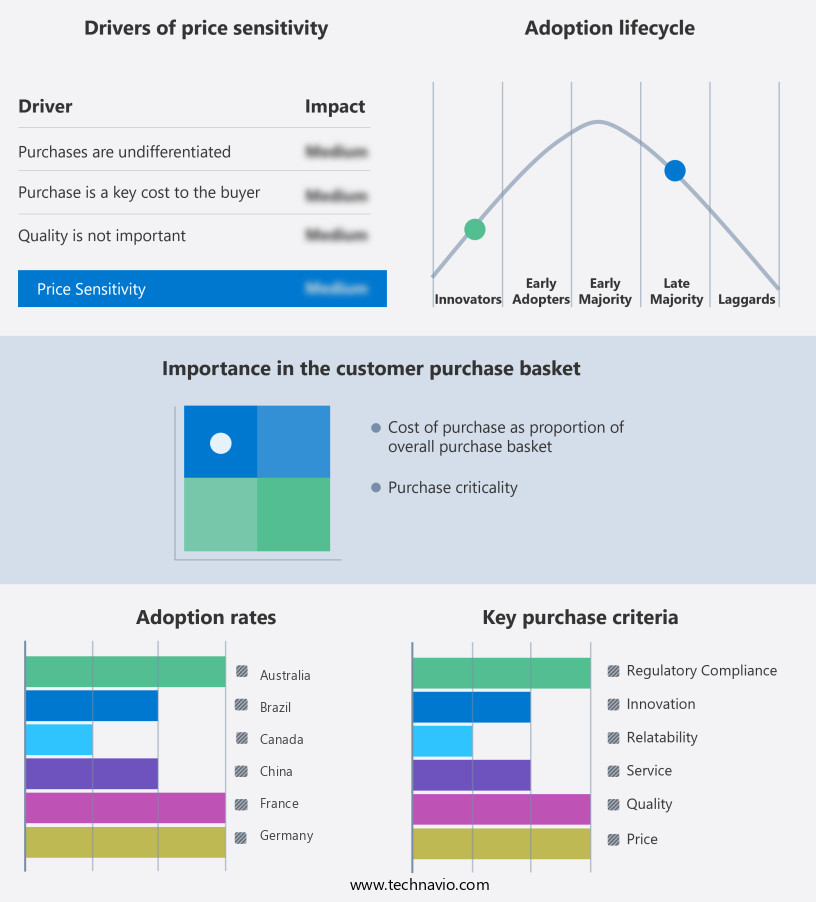
Customer Landscape of Global AI In Inflammatory Bowel Disease Industry
Competitive Landscape
Companies are implementing various strategies, such as strategic alliances, global ai in inflammatory bowel disease market forecast, partnerships, mergers and acquisitions, geographical expansion, and product/service launches, to enhance their presence in the industry.
The industry research and growth report includes detailed analyses of the competitive landscape of the market and information about key companies, including:
- AbbVie Inc.
- Bayer AG
- BenevolentAI
- Dova Health Intelligence Inc.
- F. Hoffmann La Roche Ltd.
- Insilico Medicine
- International Business Machines Corp.
- Olympus Corp.
- Owkin Inc.
- PathAI Inc.
- Pfizer Inc.
- Siemens Healthineers AG
- SingHealth Group.
- Takeda Pharmaceutical Co. Ltd.
- Tempus Labs Inc.
Qualitative and quantitative analysis of companies has been conducted to help clients understand the wider business environment as well as the strengths and weaknesses of key industry players. Data is qualitatively analyzed to categorize companies as pure play, category-focused, industry-focused, and diversified; it is quantitatively analyzed to categorize companies as dominant, leading, strong, tentative, and weak.
Recent Development and News in Global AI In Inflammatory Bowel Disease Market
- In August 2024, IBM Watson Health announced the launch of its new AI-powered diagnostic solution for Inflammatory Bowel Disease (IBD), designed to assist clinicians in diagnosing and monitoring IBD patients more accurately and efficiently. The solution uses machine learning algorithms to analyze medical images and patient data, enabling early detection and personalized treatment plans (IBM Press Release).
- In November 2024, Roche and Debiopharm Group entered into a strategic collaboration to develop an AI-driven therapeutic solution for IBD. The partnership combines Roche's expertise in pharmaceuticals and Debiopharm's AI capabilities to create a novel therapeutic approach for IBD patients (Roche Press Release).
- In February 2025, Intellicure, a digital health company, raised USD20 million in a Series C funding round led by Merck Global Health Innovation Fund. The investment will be used to expand Intellicure's AI-powered wound care platform to IBD patients, enabling more accurate diagnosis and treatment (Intellicure Press Release).
- In May 2025, the US Food and Drug Administration (FDA) granted clearance to Medtronic for its new AI-driven IBD monitoring system, which uses machine learning algorithms to analyze patient data and provide real-time insights to healthcare providers. The system is expected to improve patient outcomes and reduce hospital readmissions (Medtronic Press Release).
Dive into Technavio's robust research methodology, blending expert interviews, extensive data synthesis, and validated models for unparalleled Global AI In Inflammatory Bowel Disease Market insights. See full methodology.
|
Market Scope
|
|
Report Coverage
|
Details
|
|
Page number
|
225
|
|
Base year
|
2024
|
|
Historic period
|
2019-2023 |
|
Forecast period
|
2025-2029
|
|
Growth momentum & CAGR
|
Accelerate at a CAGR of 33.3%
|
|
Market growth 2025-2029
|
USD 312.1 million
|
|
Market structure
|
Concentrated
|
|
YoY growth 2024-2025(%)
|
31.2
|
|
Key countries
|
China, Japan, India, Australia, UK, Germany, France, US, Canada, and Brazil
|
|
Competitive landscape
|
Leading Companies, Market Positioning of Companies, Competitive Strategies, and Industry Risks
|
Request Free Sample
Research Analyst Overview
- Amidst the global healthcare landscape, the application of Artificial Intelligence (AI) in Inflammatory Bowel Disease (IBD) market continues to evolve, revolutionizing diagnosis, treatment, and patient care. AI-powered decision support systems are increasingly being adopted to optimize drug discovery in IBD, enabling researchers to identify potential therapeutic targets and biomarkers with unprecedented accuracy. Real-world evidence plays a pivotal role in IBD management, and AI's ability to analyze vast amounts of data from various sources allows for more accurate patient outcome prediction. Predictive modeling, disease severity scoring, and inflammation detection are some of the key areas where AI demonstrates significant potential.
- Image recognition technology, a subset of AI, is being utilized to analyze colitis images, enhancing diagnostic accuracy and reducing the need for invasive procedures. AI-driven diagnostics are also revolutionizing remote patient monitoring, enabling healthcare providers to assess disease progression and adjust treatment plans accordingly. Natural Language Processing (NLP) is another AI application that is gaining traction in IBD research. It facilitates the analysis of patient data and clinical trial optimization by extracting valuable insights from unstructured data sources. Cohort analysis in IBD is also benefiting from AI's capabilities, enabling researchers to identify patterns and trends that might otherwise go unnoticed.
- Deep learning algorithms are being employed in endoscopic image analysis, providing more accurate and efficient diagnoses. Personalized medicine in IBD is another area where AI is making a significant impact, as it allows for the analysis of individual patient data to tailor treatment plans and improve medication adherence. AI is also being used to analyze wearable sensor data, optimize clinical decision support, and identify biomarkers and therapeutic targets through genomic analysis. The integration of AI in IBD research is not only improving patient outcomes but also accelerating the pace of drug development. In the realm of AI-assisted surgery, risk stratification in IBD is being enhanced, enabling surgeons to make more informed decisions.
- Machine learning algorithms are being employed to analyze patient data and predict treatment response, improving overall patient care. The integration of AI in IBD research is transforming the way we approach diagnosis, treatment, and patient care. Its ability to analyze vast amounts of data from various sources, identify patterns, and provide accurate predictions is revolutionizing the field and offering new opportunities for improving patient outcomes.
What are the Key Data Covered in this Global AI In Inflammatory Bowel Disease Market Research and Growth Report?
-
What is the expected growth of the Global AI In Inflammatory Bowel Disease Market between 2025 and 2029?
-
What segmentation does the market report cover?
-
The report segmented by Disease Type (Ulcerative colitis and Crohns disease), Application (Diagnosis assistance, Treatment optimization, and Disease monitoring), End-user (Hospitals, Specialty clinics, Diagnostic laboratories, and Academic and research institutes), and Geography (North America, Europe, APAC, South America, and Middle East and Africa)
-
Which regions are analyzed in the report?
-
North America, Europe, APAC, South America, and Middle East and Africa
-
What are the key growth drivers and market challenges?
-
Imperative for enhanced diagnostic accuracy and personalized treatment pathways, Scarcity of high-quality, diverse, and accessible data
-
Who are the major players in the Global AI In Inflammatory Bowel Disease Market?
-
Key Companies AbbVie Inc., Bayer AG, BenevolentAI, Dova Health Intelligence Inc., F. Hoffmann La Roche Ltd., Insilico Medicine, International Business Machines Corp., Olympus Corp., Owkin Inc., PathAI Inc., Pfizer Inc., Siemens Healthineers AG, SingHealth Group., Takeda Pharmaceutical Co. Ltd., and Tempus Labs Inc.
Market Research Insights
- The global AI market in inflammatory bowel disease (IBD) is experiencing significant growth, driven by the integration of advanced technologies in clinical trial recruitment, genetic susceptibility assessment, telemedicine, clinical workflow optimization, and treatment efficacy monitoring. According to estimates, the market's value is projected to reach USD1.5 billion by 2026, growing at a compound annual growth rate (CAGR) of 25% from 2021. AI-powered pathology and automated image analysis are revolutionizing disease monitoring systems by enhancing diagnostic accuracy and improving clinical trial efficiency. For instance, AI algorithms can analyze imaging biomarkers and inflammation biomarkers to predict disease activity index and patient reported outcomes, enabling precision medicine in IBD.
- Furthermore, AI-based drug screening and AI-enhanced endoscopy are paving the way for personalized treatment plans and patient stratification. The integration of AI in IBD care is also facilitating remote monitoring platforms and patient engagement tools, allowing for real-time symptom tracking and predictive analytics. The potential for AI-driven drug repurposing and multi-omics analysis holds immense promise in the development of novel therapeutic interventions.
We can help! Our analysts can customize this global AI in inflammatory bowel disease market research report to meet your requirements.
Get in touch
1 Executive Summary
- 1.1 Market overview
- Executive Summary - Chart on Market Overview
- Executive Summary - Data Table on Market Overview
- Executive Summary - Chart on Global Market Characteristics
- Executive Summary - Chart on Market by Geography
- Executive Summary - Chart on Market Segmentation by Disease Type
- Executive Summary - Chart on Market Segmentation by Application
- Executive Summary - Chart on Market Segmentation by End-user
- Executive Summary - Chart on Incremental Growth
- Executive Summary - Data Table on Incremental Growth
- Executive Summary - Chart on Company Market Positioning
2 Technavio Analysis
- 2.1 Analysis of price sensitivity, lifecycle, customer purchase basket, adoption rates, and purchase criteria
- Analysis of price sensitivity, lifecycle, customer purchase basket, adoption rates, and purchase criteria
- 2.2 Criticality of inputs and Factors of differentiation
- Overview on criticality of inputs and factors of differentiation
- 2.3 Factors of disruption
- Overview on factors of disruption
- 2.4 Impact of drivers and challenges
- Impact of drivers and challenges in 2024 and 2029
3 Market Landscape
- 3.1 Market ecosystem
- Parent Market
- Data Table on - Parent Market
- 3.2 Market characteristics
- Market characteristics analysis
4 Market Sizing
- 4.1 Market definition
- Offerings of companies included in the market definition
- 4.2 Market segment analysis
- 4.4 Market outlook: Forecast for 2024-2029
- Chart on Global - Market size and forecast 2024-2029 ($ million)
- Data Table on Global - Market size and forecast 2024-2029 ($ million)
- Chart on Global Market: Year-over-year growth 2024-2029 (%)
- Data Table on Global Market: Year-over-year growth 2024-2029 (%)
5 Five Forces Analysis
- 5.1 Five forces summary
- Five forces analysis - Comparison between 2024 and 2029
- 5.2 Bargaining power of buyers
- Bargaining power of buyers - Impact of key factors 2024 and 2029
- 5.3 Bargaining power of suppliers
- Bargaining power of suppliers - Impact of key factors in 2024 and 2029
- 5.4 Threat of new entrants
- Threat of new entrants - Impact of key factors in 2024 and 2029
- 5.5 Threat of substitutes
- Threat of substitutes - Impact of key factors in 2024 and 2029
- 5.6 Threat of rivalry
- Threat of rivalry - Impact of key factors in 2024 and 2029
- 5.7 Market condition
- Chart on Market condition - Five forces 2024 and 2029
6 Market Segmentation by Disease Type
- 6.1 Market segments
- Chart on Disease Type - Market share 2024-2029 (%)
- Data Table on Disease Type - Market share 2024-2029 (%)
- 6.2 Comparison by Disease Type
- Chart on Comparison by Disease Type
- Data Table on Comparison by Disease Type
- 6.3 Ulcerative colitis - Market size and forecast 2024-2029
- Chart on Ulcerative colitis - Market size and forecast 2024-2029 ($ million)
- Data Table on Ulcerative colitis - Market size and forecast 2024-2029 ($ million)
- Chart on Ulcerative colitis - Year-over-year growth 2024-2029 (%)
- Data Table on Ulcerative colitis - Year-over-year growth 2024-2029 (%)
- 6.4 Crohns disease - Market size and forecast 2024-2029
- Chart on Crohns disease - Market size and forecast 2024-2029 ($ million)
- Data Table on Crohns disease - Market size and forecast 2024-2029 ($ million)
- Chart on Crohns disease - Year-over-year growth 2024-2029 (%)
- Data Table on Crohns disease - Year-over-year growth 2024-2029 (%)
- 6.5 Market opportunity by Disease Type
- Market opportunity by Disease Type ($ million)
- Data Table on Market opportunity by Disease Type ($ million)
7 Market Segmentation by Application
- 7.1 Market segments
- Chart on Application - Market share 2024-2029 (%)
- Data Table on Application - Market share 2024-2029 (%)
- 7.2 Comparison by Application
- Chart on Comparison by Application
- Data Table on Comparison by Application
- 7.3 Diagnosis assistance - Market size and forecast 2024-2029
- Chart on Diagnosis assistance - Market size and forecast 2024-2029 ($ million)
- Data Table on Diagnosis assistance - Market size and forecast 2024-2029 ($ million)
- Chart on Diagnosis assistance - Year-over-year growth 2024-2029 (%)
- Data Table on Diagnosis assistance - Year-over-year growth 2024-2029 (%)
- 7.4 Treatment optimization - Market size and forecast 2024-2029
- Chart on Treatment optimization - Market size and forecast 2024-2029 ($ million)
- Data Table on Treatment optimization - Market size and forecast 2024-2029 ($ million)
- Chart on Treatment optimization - Year-over-year growth 2024-2029 (%)
- Data Table on Treatment optimization - Year-over-year growth 2024-2029 (%)
- 7.5 Disease monitoring - Market size and forecast 2024-2029
- Chart on Disease monitoring - Market size and forecast 2024-2029 ($ million)
- Data Table on Disease monitoring - Market size and forecast 2024-2029 ($ million)
- Chart on Disease monitoring - Year-over-year growth 2024-2029 (%)
- Data Table on Disease monitoring - Year-over-year growth 2024-2029 (%)
- 7.6 Market opportunity by Application
- Market opportunity by Application ($ million)
- Data Table on Market opportunity by Application ($ million)
8 Market Segmentation by End-user
- 8.1 Market segments
- Chart on End-user - Market share 2024-2029 (%)
- Data Table on End-user - Market share 2024-2029 (%)
- 8.2 Comparison by End-user
- Chart on Comparison by End-user
- Data Table on Comparison by End-user
- 8.3 Hospitals - Market size and forecast 2024-2029
- Chart on Hospitals - Market size and forecast 2024-2029 ($ million)
- Data Table on Hospitals - Market size and forecast 2024-2029 ($ million)
- Chart on Hospitals - Year-over-year growth 2024-2029 (%)
- Data Table on Hospitals - Year-over-year growth 2024-2029 (%)
- 8.4 Specialty clinics - Market size and forecast 2024-2029
- Chart on Specialty clinics - Market size and forecast 2024-2029 ($ million)
- Data Table on Specialty clinics - Market size and forecast 2024-2029 ($ million)
- Chart on Specialty clinics - Year-over-year growth 2024-2029 (%)
- Data Table on Specialty clinics - Year-over-year growth 2024-2029 (%)
- 8.5 Diagnostic laboratories - Market size and forecast 2024-2029
- Chart on Diagnostic laboratories - Market size and forecast 2024-2029 ($ million)
- Data Table on Diagnostic laboratories - Market size and forecast 2024-2029 ($ million)
- Chart on Diagnostic laboratories - Year-over-year growth 2024-2029 (%)
- Data Table on Diagnostic laboratories - Year-over-year growth 2024-2029 (%)
- 8.6 Academic and research institutes - Market size and forecast 2024-2029
- Chart on Academic and research institutes - Market size and forecast 2024-2029 ($ million)
- Data Table on Academic and research institutes - Market size and forecast 2024-2029 ($ million)
- Chart on Academic and research institutes - Year-over-year growth 2024-2029 (%)
- Data Table on Academic and research institutes - Year-over-year growth 2024-2029 (%)
- 8.7 Market opportunity by End-user
- Market opportunity by End-user ($ million)
- Data Table on Market opportunity by End-user ($ million)
9 Customer Landscape
- 9.1 Customer landscape overview
- Analysis of price sensitivity, lifecycle, customer purchase basket, adoption rates, and purchase criteria
10 Geographic Landscape
- 10.1 Geographic segmentation
- Chart on Market share by geography 2024-2029 (%)
- Data Table on Market share by geography 2024-2029 (%)
- 10.2 Geographic comparison
- Chart on Geographic comparison
- Data Table on Geographic comparison
- 10.3 North America - Market size and forecast 2024-2029
- Chart on North America - Market size and forecast 2024-2029 ($ million)
- Data Table on North America - Market size and forecast 2024-2029 ($ million)
- Chart on North America - Year-over-year growth 2024-2029 (%)
- Data Table on North America - Year-over-year growth 2024-2029 (%)
- 10.4 Europe - Market size and forecast 2024-2029
- Chart on Europe - Market size and forecast 2024-2029 ($ million)
- Data Table on Europe - Market size and forecast 2024-2029 ($ million)
- Chart on Europe - Year-over-year growth 2024-2029 (%)
- Data Table on Europe - Year-over-year growth 2024-2029 (%)
- 10.5 APAC - Market size and forecast 2024-2029
- Chart on APAC - Market size and forecast 2024-2029 ($ million)
- Data Table on APAC - Market size and forecast 2024-2029 ($ million)
- Chart on APAC - Year-over-year growth 2024-2029 (%)
- Data Table on APAC - Year-over-year growth 2024-2029 (%)
- 10.6 South America - Market size and forecast 2024-2029
- Chart on South America - Market size and forecast 2024-2029 ($ million)
- Data Table on South America - Market size and forecast 2024-2029 ($ million)
- Chart on South America - Year-over-year growth 2024-2029 (%)
- Data Table on South America - Year-over-year growth 2024-2029 (%)
- 10.7 Middle East and Africa - Market size and forecast 2024-2029
- Chart on Middle East and Africa - Market size and forecast 2024-2029 ($ million)
- Data Table on Middle East and Africa - Market size and forecast 2024-2029 ($ million)
- Chart on Middle East and Africa - Year-over-year growth 2024-2029 (%)
- Data Table on Middle East and Africa - Year-over-year growth 2024-2029 (%)
- 10.8 US - Market size and forecast 2024-2029
- Chart on US - Market size and forecast 2024-2029 ($ million)
- Data Table on US - Market size and forecast 2024-2029 ($ million)
- Chart on US - Year-over-year growth 2024-2029 (%)
- Data Table on US - Year-over-year growth 2024-2029 (%)
- 10.9 China - Market size and forecast 2024-2029
- Chart on China - Market size and forecast 2024-2029 ($ million)
- Data Table on China - Market size and forecast 2024-2029 ($ million)
- Chart on China - Year-over-year growth 2024-2029 (%)
- Data Table on China - Year-over-year growth 2024-2029 (%)
- 10.10 UK - Market size and forecast 2024-2029
- Chart on UK - Market size and forecast 2024-2029 ($ million)
- Data Table on UK - Market size and forecast 2024-2029 ($ million)
- Chart on UK - Year-over-year growth 2024-2029 (%)
- Data Table on UK - Year-over-year growth 2024-2029 (%)
- 10.11 Germany - Market size and forecast 2024-2029
- Chart on Germany - Market size and forecast 2024-2029 ($ million)
- Data Table on Germany - Market size and forecast 2024-2029 ($ million)
- Chart on Germany - Year-over-year growth 2024-2029 (%)
- Data Table on Germany - Year-over-year growth 2024-2029 (%)
- 10.12 Japan - Market size and forecast 2024-2029
- Chart on Japan - Market size and forecast 2024-2029 ($ million)
- Data Table on Japan - Market size and forecast 2024-2029 ($ million)
- Chart on Japan - Year-over-year growth 2024-2029 (%)
- Data Table on Japan - Year-over-year growth 2024-2029 (%)
- 10.13 Canada - Market size and forecast 2024-2029
- Chart on Canada - Market size and forecast 2024-2029 ($ million)
- Data Table on Canada - Market size and forecast 2024-2029 ($ million)
- Chart on Canada - Year-over-year growth 2024-2029 (%)
- Data Table on Canada - Year-over-year growth 2024-2029 (%)
- 10.14 India - Market size and forecast 2024-2029
- Chart on India - Market size and forecast 2024-2029 ($ million)
- Data Table on India - Market size and forecast 2024-2029 ($ million)
- Chart on India - Year-over-year growth 2024-2029 (%)
- Data Table on India - Year-over-year growth 2024-2029 (%)
- 10.15 France - Market size and forecast 2024-2029
- Chart on France - Market size and forecast 2024-2029 ($ million)
- Data Table on France - Market size and forecast 2024-2029 ($ million)
- Chart on France - Year-over-year growth 2024-2029 (%)
- Data Table on France - Year-over-year growth 2024-2029 (%)
- 10.16 Brazil - Market size and forecast 2024-2029
- Chart on Brazil - Market size and forecast 2024-2029 ($ million)
- Data Table on Brazil - Market size and forecast 2024-2029 ($ million)
- Chart on Brazil - Year-over-year growth 2024-2029 (%)
- Data Table on Brazil - Year-over-year growth 2024-2029 (%)
- 10.17 Australia - Market size and forecast 2024-2029
- Chart on Australia - Market size and forecast 2024-2029 ($ million)
- Data Table on Australia - Market size and forecast 2024-2029 ($ million)
- Chart on Australia - Year-over-year growth 2024-2029 (%)
- Data Table on Australia - Year-over-year growth 2024-2029 (%)
- 10.18 Market opportunity by geography
- Market opportunity by geography ($ million)
- Data Tables on Market opportunity by geography ($ million)
11 Drivers, Challenges, and Opportunity/Restraints
- 11.3 Impact of drivers and challenges
- Impact of drivers and challenges in 2024 and 2029
- 11.4 Market opportunities/restraints
12 Competitive Landscape
- 12.2 Competitive Landscape
- Overview on criticality of inputs and factors of differentiation
- 12.3 Landscape disruption
- Overview on factors of disruption
- 12.4 Industry risks
- Impact of key risks on business
13 Competitive Analysis
- 13.2 Company ranking index
- 13.3 Market positioning of companies
- Matrix on companies position and classification
- 13.4 AbbVie Inc.
- AbbVie Inc. - Overview
- AbbVie Inc. - Product / Service
- AbbVie Inc. - Key news
- AbbVie Inc. - Key offerings
- SWOT
- 13.5 Bayer AG
- Bayer AG - Overview
- Bayer AG - Business segments
- Bayer AG - Key news
- Bayer AG - Key offerings
- Bayer AG - Segment focus
- SWOT
- 13.6 BenevolentAI
- BenevolentAI - Overview
- BenevolentAI - Product / Service
- BenevolentAI - Key offerings
- SWOT
- 13.7 Dova Health Intelligence Inc.
- Dova Health Intelligence Inc. - Overview
- Dova Health Intelligence Inc. - Product / Service
- Dova Health Intelligence Inc. - Key offerings
- SWOT
- 13.8 F. Hoffmann La Roche Ltd.
- F. Hoffmann La Roche Ltd. - Overview
- F. Hoffmann La Roche Ltd. - Business segments
- F. Hoffmann La Roche Ltd. - Key news
- F. Hoffmann La Roche Ltd. - Key offerings
- F. Hoffmann La Roche Ltd. - Segment focus
- SWOT
- 13.9 Insilico Medicine
- Insilico Medicine - Overview
- Insilico Medicine - Product / Service
- Insilico Medicine - Key offerings
- SWOT
- 13.10 International Business Machines Corp.
- International Business Machines Corp. - Overview
- International Business Machines Corp. - Business segments
- International Business Machines Corp. - Key news
- International Business Machines Corp. - Key offerings
- International Business Machines Corp. - Segment focus
- SWOT
- 13.11 Olympus Corp.
- Olympus Corp. - Overview
- Olympus Corp. - Business segments
- Olympus Corp. - Key news
- Olympus Corp. - Key offerings
- Olympus Corp. - Segment focus
- SWOT
- 13.12 Owkin Inc.
- Owkin Inc. - Overview
- Owkin Inc. - Product / Service
- Owkin Inc. - Key offerings
- SWOT
- 13.13 PathAI Inc.
- PathAI Inc. - Overview
- PathAI Inc. - Product / Service
- PathAI Inc. - Key offerings
- SWOT
- 13.14 Pfizer Inc.
- Pfizer Inc. - Overview
- Pfizer Inc. - Product / Service
- Pfizer Inc. - Key news
- Pfizer Inc. - Key offerings
- SWOT
- 13.15 Siemens Healthineers AG
- Siemens Healthineers AG - Overview
- Siemens Healthineers AG - Business segments
- Siemens Healthineers AG - Key news
- Siemens Healthineers AG - Key offerings
- Siemens Healthineers AG - Segment focus
- SWOT
- 13.16 SingHealth Group.
- SingHealth Group. - Overview
- SingHealth Group. - Product / Service
- SingHealth Group. - Key offerings
- SWOT
- 13.17 Takeda Pharmaceutical Co. Ltd.
- Takeda Pharmaceutical Co. Ltd. - Overview
- Takeda Pharmaceutical Co. Ltd. - Product / Service
- Takeda Pharmaceutical Co. Ltd. - Key news
- Takeda Pharmaceutical Co. Ltd. - Key offerings
- SWOT
- 13.18 Tempus Labs Inc.
- Tempus Labs Inc. - Overview
- Tempus Labs Inc. - Product / Service
- Tempus Labs Inc. - Key offerings
- SWOT
14 Appendix
- 14.2 Inclusions and exclusions checklist
- Inclusions checklist
- Exclusions checklist
- 14.3 Currency conversion rates for US$
- Currency conversion rates for US$
- 14.4 Research methodology
- 14.7 Validation techniques employed for market sizing
- Validation techniques employed for market sizing
- 14.9 360 degree market analysis
- 360 degree market analysis
- 14.10 List of abbreviations







![]() Get the report (PDF) sent to your email within minutes.
Get the report (PDF) sent to your email within minutes.
Complimentary full Excel data with your report purchase.